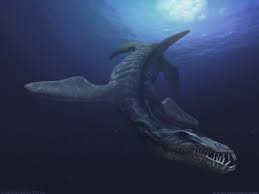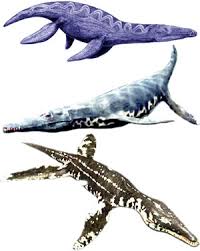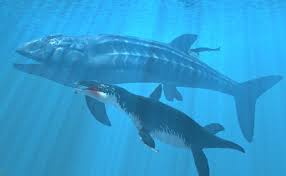LIOUPLEURODON INFORMATION
pleurodon (pronounced /ˌlaɪ.ɵˈplʊərədɒn/, meaning 'smooth-sided teeth') is a genus of large, carnivorous marine reptile belonging to thePliosauroidea, a clade of short-necked plesiosaurs. Two species ofLiopleurodon lived during the Callovian stage of the Middle JurassicPeriod (c. 160 to 155 mya), while the third, L. rossicus, lived during the Late Jurassic. It was the apex predator of the Middle to Late Jurassic seas that covered Europe.
pleurodon (pronounced /ˌlaɪ.ɵˈplʊərədɒn/, meaning 'smooth-sided teeth') is a genus of large, carnivorous marine reptile belonging to thePliosauroidea, a clade of short-necked plesiosaurs. Two species ofLiopleurodon lived during the Callovian stage of the Middle JurassicPeriod (c. 160 to 155 mya), while the third, L. rossicus, lived during the Late Jurassic. It was the apex predator of the Middle to Late Jurassic seas that covered Europe.

The genus nameLiopleurodon was coined by Henri-Émile Sauvage in 1873 on the basis of very poor remains consisting of three 70 millimeter teeth. One


tooth was found near Boulogne-sur-Mer, France in layers dating from theCallovian was namedLiopleurodon ferox, another from Charly, France was named Liopleurodon grossouvrei, while a third discovered nearCaen, France was originally described asPoikilopleuron bucklandiand ascribed by Sauvage to the species Liopleurodon bucklandi. Sauvage did not ascribe the genus to any particular group of reptiles in his descriptions.Discovery and species
Liopleurodon fossils have been found mainly in England and France, with one younger species known from Russia. Fossil specimens that are contemporary (Callovian) with those from England and France referrable to Liopleurodon are known from Germany.Currently, there are three recognized species within Liopleurodon. From the Callovian of England and France L. ferox is well known; while also from the Callovian of England is the rarer L. pachydeirus, described by Seeley as a Pliosaurus (1869).L. rossicus is known from the earlyTithonian (Volga Beds) of Russia. This species was initially described by Novozhilov (in 1948) as belonging to Pliosaurus, and is the type species of the genus Strongylokroptaphus.Only L. ferox is known from more or less complete skeletons.Palaeobiology
Four strong paddle-like limbs suggest that Liopleurodonwas a powerful swimmer. Its four-flipper mode of propulsion is characteristic of all plesiosaurs. A study involving a swimming robot has demonstrated that although this form of propulsion is not especially efficient, it provides very good acceleration - a desirable trait in an ambush predator. Studies of the skull have shown that it could probably scan the water with its nostrils to ascertain the source of certain smells.Size
Estimating the maximum size of Liopleurodon has become a controversial subject. The palaeontologist L. B. Tarlo suggested that the total body length of a pliosaur (including Liopleurodon) can be estimated from its skull length. Tarlo claimed that the skull of a pliosaur is typically about one-seventh of the total body length. The largest known skull belonging to L. ferox is 1.5 metres (4.9 ft) long.According to Tarlo's hypothesis, this specimen would be around 10.5metres (34 ft) long. However, the case of Kronosaurus exposed some uncertainty about the accuracy of Tarlo's suggestion.[9]New research on pliosaur anatomy has cast doubt on Tarlo's hypothesis for estimating the size of pliosaurs and revealed that pliosaur skulls were typically about one-fifth of the total body length. L. ferox, with a 1.5metres (4.9 ft) long skull, would realistically be approximately 7.5metres (25 ft) long. An exceptionally well-preserved skeleton of L. feroxis on display in the Institut und Museum für Geologie und Paläontologie der Universität Tübingen in Germany. This specimen is around 4.5metres (15 ft) long. Fossil remains of another specimen identified asL. ferox have been excavated from an Oxford Clay formation nearPeterborough. This specimen has been estimated to be 6.39 metres(21.0 ft) in length with a skull length of about 1.26 metres (4.1 ft) and is regarded as an adult individual.An adult L. ferox would have averaged 5–7 metres (16–23 ft) long.Some fossil remains excavated from the Kimmeridge Clay formation inEngland indicate a much larger taxon, possibly up to 15 metres (49 ft) long. However, these have not been assigned to the LiopleurodongenusA partial specimen of a jaw mandible measuring 2.875 metres (9.43 ft) is on display in the Oxford University Museum of Natural History: it is estimated that the total length of the jaw is in excess of 3 metres(9.8 ft). The specimen was originally assigned to the Stretosaurusgenus (as Stretosaurus macromerus), but is currently believed to belong to the Liopleurodon genus and has been renamed L. macromerus. The genus Stretosaurus later became a junior synonym ofLiopleurodon. However, it has been re-classified as Pliosaurus macromerus.In 2002, the discovery was announced of a very large pliosaur, inMexico's La Caja formation. The specimen, dubbed "the Monster of Aramberri", is estimated at 15 metres (49 ft) long on the basis of the size of its vertebral centrum, which are 22 cm in diameter. However, this specimen is believed to have been a young individual. It was widely reported by media sources as belonging to genus Liopleurodon, although no taxonomic justification for this assignment could be provided: poorly-preserved fossil remains have precluded any proper taxonomic assignment. This pliosaur dates from the Kimmeridgianage.Experts suggest that this pliosaur could have approached 18metres (59 ft) in total length.In popular culture
In 1999, Liopleurodon was featured in an episode the BBC television series Walking with Dinosaurs. In the programme, Liopleurodon was depicted attacking and devouring the theropod dinosaurEustreptospondylus, before becoming beached during a typhoon and suffocating under its own weight. The depiction of Liopleurodon leaping onto the land in order to catch land-based prey is entirely speculative, and the programme's producers stated in the commentary for the DVD release of the series that this behaviour was inspired by that oforcas. The size of Liopleurodon in Walking with Dinosaurs, which depicts an enormous 25 metre-long animal, is not considered to be accurate for any species of Liopleurodon.In his 2009 novel Meg: Hell's Aquarium, science fiction author Steve Alten included a Liopleurodon in the plot. Alten took several creative liberties, such as listing the animal's length at 122 feet and depicting the creature with gillsThe genus nameLiopleurodon was coined by Henri-Émile Sauvage in 1873 on the basis of very poor remains consisting of three 70 millimeter teeth. One tooth was found near Boulogne-sur-Mer, France in layers dating from theCallovian was namedLiopleurodon ferox, another from Charly, France was namedLiopleurodon grossouvrei, while a third discovered nearCaen, France was originally described asPoikilopleuron bucklandiand ascribed by Sauvage to the species Liopleurodon bucklandi. Sauvage did not ascribe the genus to any particular group of reptiles in his descriptions.Discovery and species
The genus nameLiopleurodon was coined by Henri-Émile Sauvage in 1873 on the basis of very poor remains consisting of three 70 millimeter teeth. One
Liopleurodon fossils have been found mainly in England and France, with one younger species known from Russia. Fossil specimens that are contemporary (Callovian) with those from England and France referrable to Liopleurodon are known from Germany.
Currently, there are three recognized species within Liopleurodon. From the Callovian of England and France L. ferox is well known; while also from the Callovian of England is the rarer L. pachydeirus, described by Seeley as a Pliosaurus (1869). L. rossicus is known from the earlyTithonian (Volga Beds) of Russia. This species was initially described by Novozhilov (in 1948) as belonging to Pliosaurus, and is the type species of the genus Strongylokroptaphus. Only L. ferox is known from more or less complete skeletons.
Palaeobiology
Four strong paddle-like limbs suggest that Liopleurodonwas a powerful swimmer. Its four-flipper mode of propulsion is characteristic of all plesiosaurs. A study involving a swimming robot has demonstrated that although this form of propulsion is not especially efficient, it provides very good acceleration - a desirable trait in an ambush predator. Studies of the skull have shown that it could probably scan the water with its nostrils to ascertain the source of certain smells.
Size
Estimating the maximum size of Liopleurodon has become a controversial subject. The palaeontologist L. B. Tarlo suggested that the total body length of a pliosaur (including Liopleurodon) can be estimated from its skull length. Tarlo claimed that the skull of a pliosaur is typically about one-seventh of the total body length. The largest known skull belonging to L. ferox is 1.5 metres (4.9 ft) long.According to Tarlo's hypothesis, this specimen would be around 10.5metres (34 ft) long. However, the case of Kronosaurus exposed some uncertainty about the accuracy of Tarlo's suggestion
New research on pliosaur anatomy has cast doubt on Tarlo's hypothesis for estimating the size of pliosaurs and revealed that pliosaur skulls were typically about one-fifth of the total body length. L. ferox, with a 1.5metres (4.9 ft) long skull, would realistically be approximately 7.5metres (25 ft) long. An exceptionally well-preserved skeleton of L. feroxis on display in the Institut und Museum für Geologie und Paläontologie der Universität Tübingen in Germany. This specimen is around 4.5metres (15 ft) longFossil remains of another specimen identified asL. ferox have been excavated from an Oxford Clay formation nearPeterborough. This specimen has been estimated to be 6.39 metres(21.0 ft) in length with a skull length of about 1.26 metres (4.1 ft) and is regarded as an adult individual. An adult L. ferox would have averaged 5–7 metres (16–23 ft) long.
Some fossil remains excavated from the Kimmeridge Clay formation inEngland indicate a much larger taxon, possibly up to 15 metres (49 ft) long. However, these have not been assigned to the Liopleurodongenus.
A partial specimen of a jaw mandible measuring 2.875 metres (9.43 ft) is on display in the Oxford University Museum of Natural History: it is estimated that the total length of the jaw is in excess of 3 metres(9.8 ft). The specimen was originally assigned to the Stretosaurusgenus (as Stretosaurus macromerus), but is currently believed to belong to the Liopleurodon genus and has been renamed L. macromerus. The genus Stretosaurus later became a junior synonym ofLiopleurodon However, it has been re-classified as Pliosaurus macromerus.
In 2002, the discovery was announced of a very large pliosaur, inMexico's La Caja formation. The specimen, dubbed "the Monster of Aramberri", is estimated at 15 metres (49 ft) long on the basis of the size of its vertebral centrum, which are 22 cm in diameter.However, this specimen is believed to have been a young individual. It was widely reported by media sources as belonging to genus Liopleurodon, although no taxonomic justification for this assignment could be provided: poorly-preserved fossil remains have precluded any proper taxonomic assignment. This pliosaur dates from the Kimmeridgianage. Experts suggest that this pliosaur could have approached 18metres (59 ft) in total length.
In popular culture
In 1999, Liopleurodon was featured in an episode the BBC television series Walking with Dinosaurs. In the programme, Liopleurodon was depicted attacking and devouring the theropod dinosaurEustreptospondylus, before becoming beached during a typhoon and suffocating under its own weight. The depiction of Liopleurodon leaping onto the land in order to catch land-based prey is entirely speculative, and the programme's producers stated in the commentary for the DVD release of the series that this behaviour was inspired by that oforcas.The size of Liopleurodon in Walking with Dinosaurs, which depicts an enormous 25 metre-long animal, is not considered to be accurate for any species of Liopleurodon
In his 2009 novel Meg: Hell's Aquarium, science fiction author Steve Alten included a Liopleurodon in the plot. Alten took several creative liberties, such as listing the animal's length at 122 feet and depicting the creature with gills.







Tidak ada komentar:
Posting Komentar